Egg cell
| Egg cell | |
|---|---|
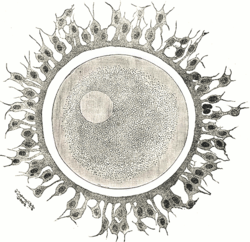 A human egg cell with surrounding corona radiata | |
| Details | |
| Identifiers | |
| Latin | ovum |
| Greek | Ωάριο (oário) |
| MeSH | D010063 |
| FMA | 67343 |
| Anatomical terms of microanatomy | |
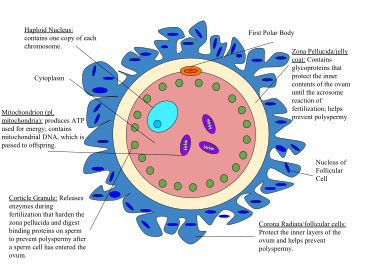
The egg cell or ovum (pl.: ova) is the
When egg and sperm fuse during
History
While the non-mammalian animal egg was obvious, the doctrine ex ovo omne vivum ("every living [animal comes from] an egg"), associated with
Animals
In animals, egg cells are also known as ova (singular ovum, from the
Studies performed on humans, dogs, and cats in the 1870s suggested that the production of
Mammals including humans

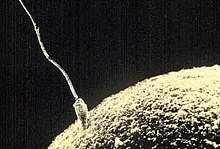
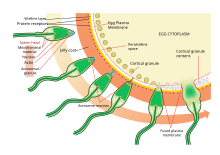
In all
The human ova grow from primitive germ cells that are embedded in the substance of the ovaries. Each of them divides repeatedly to give secretions of the uterine glands, ultimately forming a blastocyst.[10]
The ovum is one of the largest
Ooplasm
Ooplasm is like the yolk of the ovum, a cell substance at its center, which contains its
The ooplasm consists of the
Mammalian ova contain only a tiny amount of the nutritive yolk, for nourishing the embryo in the early stages of its development only. In contrast, bird eggs contain enough to supply the chick with nutriment throughout the whole period of incubation.[13]
Ova development in oviparous animals
In the
The egg cell's
Ovoviviparity
There is an intermediate form, the ovoviviparous animals: the embryo develops within and is nourished by an egg as in the oviparous case, but then it hatches inside the mother's body shortly before birth, or just after the egg leaves the mother's body. Some fish, reptiles and many invertebrates use this technique.
Plants
Nearly all land plants have alternating
In
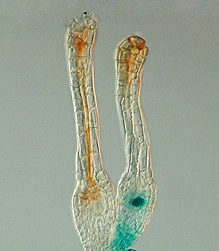
In the
Other organisms
In algae, the egg cell is often called oosphere.[citation needed] Drosophila oocytes develop in individual egg chambers that are supported by nurse cells and surrounded by somatic follicle cells. The nurse cells are large polyploid cells that synthesize and transfer RNA, proteins, and organelles to the oocytes. This transfer is followed by the programmed cell death (apoptosis) of the nurse cells. During oogenesis, 15 nurse cells die for every oocyte that is produced.[16] In addition to this developmentally regulated cell death, egg cells may also undergo apoptosis in response to starvation and other insults.[16]
See also
References
- ^ "Ovum". Biology Dictionary. BiologyOnline. 7 October 2019. Retrieved 21 January 2023.
- ^ "Oosphere Meaning". YourDictionary. Retrieved 12 April 2021.
- PMID 22827343.
- ^ ""Conclusio" from Carl Ernst von Baer's De Ovi Mammalium et..." (jpeg).
- ^ Needham, Joseph (1959). A History of Embryology (2nd, revised ed.). Cambridge, England, UK: Cambridge University Press.
- S2CID 86828337.
- ^ Lewis, Charlton T.; Short, Charles (1879). "ōvum". A Latin Dictionary. Perseus Digital Library.
- S2CID 207156647.
- PMID 30601039.
- ISBN 9780122272455. Retrieved 3 November 2013.
- ISBN 978-1-86891-380-0.
- ISBN 0-8153-3218-1.
- ^ a b c "The Ovum". Gray's Anatomy. Retrieved 18 October 2010.
- ^ ISBN 978-0-471-24520-9.
- PMID 19542356.
- ^ PMID 15355784.
External links
- The Ovarian Kaleidoscope Database description of 1800 genes involved in ovarian functions
